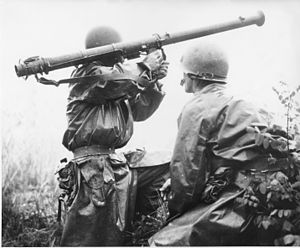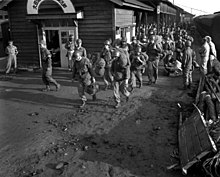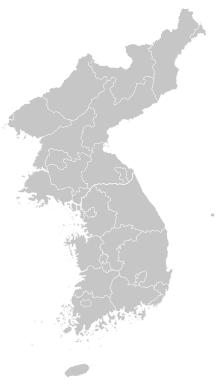Battle of Osan
| Battle of Osan | |||||||
|---|---|---|---|---|---|---|---|
| Part of the Korean War | |||||||
 A US soldier, Robert L. Witzig, with a 2.36-inch bazooka prepares to take aim at a North Korean tank during the Battle of Pyongtaek which took place after the Battle of Osan. On his right is Kenneth R. Shadrick, who was later reported as the first American killed in the Korean War. | |||||||
| |||||||
| Belligerents | |||||||
|
| |||||||
| Commanders and leaders | |||||||
|
Charles Bradford Smith Miller O. Perry |
Lee Kwon-mu Ryu Kyong-su | ||||||
| Units involved | |||||||
|
1st Battalion, 21st Infantry Battery A 52nd Field Artillery Battalion |
4th Infantry Division
| ||||||
| Strength | |||||||
| 540 infantry and support |
5,000 infantry 36 tanks | ||||||
| Casualties and losses | |||||||
|
60 killed[1] 21 wounded[1] 82 captured[a] 1 howitzer destroyed 5 howitzers disabled |
42 killed 85 wounded 1 tank destroyed 3 tanks disabled | ||||||
Location within Korea | |||||||
The Battle of Osan (
A North Korean tank column equipped with ex-Soviet T-34/85 tanks overran the task force in the first encounter and continued its advance south. After the North Korean tank column had breached US lines, the task force opened fire on a force of some 5,000 North Korean infantry that were approaching its position, which held up their advance. North Korean troops eventually flanked and overwhelmed the US positions, and the rest of the task force retreated in disorder.
Outbreak of war
During the night of June 25, 1950, ten divisions of the
To prevent South Korea's collapse, the
Division Commander
Task Force Smith
When you get to
Pusan, head for Taejon. We want to stop the North Koreans as far from Pusan as we can. Block the main road as far north as possible. Make contact with General Church. If you can't find him, go to Taejon and beyond if you can. Sorry I can't give you more information—that's all I've got. Good luck, and God bless you and your men!— Major General William F. Dean's orders to Colonel Smith[9]

The first units of the 24th Infantry Division left
Most of the soldiers of the task force were teenagers with no combat experience and only eight weeks
Task Force Smith order of battle
- 1st Battalion, 21st Infantry
- Headquarters Platoon
- B Company
- C Company
- Heavy Weapons Platoon
- 52nd Field Artillery Battalion
- A Battery
By July 1,
Three days later, on July 4,[18] it dug in on two hills straddling the road north of the village of Osan, 6 miles (9.7 km) south of Suwon and about 25 miles (40 km) south of Seoul.[9][24] The ridges rose to 300 ft (91 m) above the road, which provided visibility almost the entire distance to Suwon. The battalion set up a 1 mi (1.6 km) line over the ridges.[17] There, they waited to meet the advancing North Korean forces.[7] The force was placed along the road with the infantry formations on the two hills, five of the howitzers 1 mi (1.6 km) behind the infantry, and the sixth with its six HEAT shells positioned halfway between the infantry and the other five field artillery pieces.[25] Heavy rain made air support impossible and so Smith and Perry preregistered the artillery battery in the hope it would be just as effective.[13] The heavy machine guns and bazookas of A Battery along with a volunteer crew were sent forward to reinforce the infantry.[14]
Battle
Tank columns
At around 0730 on July 5,

Once the tanks reached the infantry line
The second column of 25 T-34 tanks approached the task force within an hour. The new T-34 formation advanced singly or by twos and threes close together with no apparent formal organization. The howitzer battery hit another tank from the column in its tracks, disabled it, and damaged three more. The North Korean tanks had destroyed the forward howitzer (number six) and wounded one of its crew members, killed or wounded an estimated 20 infantrymen, and destroyed all of the parked vehicles behind the infantry line. At the main battery position, one of the five remaining 105 mm guns had been slightly damaged by a near-hit.[1][31] Several of the men in the artillery battery began deserting their positions, but Perry managed to convince most of them to return.[32] Although Smith later stated that he believed that the rounds had deteriorated with age, the ineffectiveness of the 2.36-inch bazooka had been demonstrated repeatedly during World War II against German armor.[33] Because of peacetime defense cutbacks, the 24th Infantry Division had never received improved M20 3.5-inch bazookas with M28A2 HEAT antitank ammunition, which could defeat Soviet tanks.[34] After the last tanks had passed their lines, no North Korean forces were spotted for around an hour.[32]
Infantry column

Three more tanks were sighted advancing from the north at around 11:00.
At 11:45, when the column had advanced to within 1,000 yd (910 m) of the Americans, Smith gave the order for the task force to open fire with everything that it had.[1] The mortar, machine gun, artillery, and rifle fire destroyed several trucks, which scattered the column. The three lead tanks moved to within 300 m (980 ft) of Task Force Smith and opened fire. Behind them, around 1,000 of the infantry formed in the rice paddies to the east of the road in an attempt to flank the American forces, but they were repulsed. Smith attempted to order artillery fire on the North Korean force, but runners were unable to get back to the field artillery positions and so he assumed they had been destroyed by the tanks.[35] Within 45 minutes, another enveloping force formed to the west of the road, which forced Smith to withdraw a platoon to the east side of the road. The US infantry then began to take mortar and artillery fire from the North Koreans.[1][36]
American withdrawal
Task Force Smith managed to hold its lines for three hours, but at 14:30, Smith ordered the Americans to withdraw since they suffered from low ammunition and a breakdown of communications.

The retreat quickly broke down into a confused and disorganized
Task Force Smith's force had 250 return to the American lines before nightfall, with about 150 more of the force killed, wounded, or missing. Most of the other stragglers found their way into the American lines over the next several days. The last stragglers from 2nd Platoon, B Company, reached Chonan five days later, only 30 minutes ahead of the North Korean Army. Upon the initial count, Task Force Smith suffered 20 killed in action, 130 wounded in action or missing in action, and around 36 captured.[39] After the end of the war, the figures were revised to 60 dead, 21 wounded and 82 captured, 32 of whom died in captivity. That casualty count accounted for 40% of Task Force Smith.[1] The US troops advancing northward during the Pusan breakout offensive would later discover a series of shallow graves containing the bodies of several soldiers of the 24th Infantry Division. All of them had been shot in the back of the head, with their hands bound behind their backs with communications wire.[41] North Korean casualties were approximately 42 dead and 85 wounded, with four tanks destroyed or immobilized. The North Korean advance was delayed approximately seven hours.[37][42]
Aftermath

The Battle of Osan was the first US ground action of the war.[43] The fight showed that American forces were weak and unprepared for the war, and outdated equipment was insufficient to fight North Korean armor and poorly trained and inexperienced units were no match for better-trained North Korean troops,[1] but the disparity in number of troops engaged certainly had a profound effect on the outcome of that battle and others. Undisciplined US troops abandoned their positions prematurely and left equipment and wounded for North Korean troops to capture.[37] Smith also said he felt he had stayed too long in his position, which allowed North Korean troops to envelop the force and cause heavy casualties as it retreated.[1] Those weaknesses would play out with other US units for the next month as North Korean troops pushed them further back.[44]
Though the force was badly defeated, Task Force Smith accomplished its mission of delaying North Korean forces from advancing for several hours.
Three months later, on September 19, Osan would be the location where the US and UN forces, under the command of the Eighth Army, advancing from the south, would meet up with forces of
In the years after the Korean War, the US Army used the areas in Japan that Task Force Smith had trained as a memorial. A monument to Task Force Smith was also established on the Osan battlefield,[49] where an annual commemoration of the Battle of Osan is held by the Eighth Army, which is still headquartered in South Korea.[50] On July 16, 2010, sixty years after the Battle of Osan, Eighth Army leaders, in conjunction with government officials of Osan, held another ceremony, speaking of Task Force Smith and describing the engagement as "the opening shots of a war of ideas that exists even today."[51] On the 61st anniversary, another ceremony was held by both the US military and Osan politicians to remember the task force.[52]
Memorial
There is a memorial park - 'Osan Jukmiryeong Peace Park' in Osan. This park has museum and monument and opened in July 2020.[53]
Notes
- ^ Several of the captured American servicemen were executed by the North Koreans.
References
- ^ a b c d e f g h i j k l m n o p Millett 2010, p. 138.
- ^ Alexander 2003, p. 1.
- ^ Alexander 2003, p. 2.
- ^ Varhola 2000, p. 2.
- ^ Malkasian 2001, p. 23.
- ^ a b c Malkasian 2001, p. 24.
- ^ a b c d e Varhola 2000, p. 3.
- ^ Appleman 1998, p. 61.
- ^ a b c d Alexander 2003, p. 55.
- ^ Varhola 2000, p. 74.
- ^ a b c d Alexander 2003, p. 58.
- ^ a b c Millett 2010, p. 135.
- ^ a b c Millett 2010, p. 137.
- ^ a b Appleman 1998, p. 68.
- ^ Hanson 2010, p. 8.
- ^ Alexander 2003, p. 53.
- ^ a b c Fehrenbach 2001, p. 65.
- ^ a b Millett 2010, p. 136.
- ^ Varhola 2000, p. 84.
- ^ Alexander 2003, p. 54.
- ^ Gal Perl Finkel, President-elect Trump – the 'West Wing' lesson, The Jerusalem Post, November 15, 2016.
- ^ Alexander 2003, p. 52.
- ^ Catchpole 2001, p. 13.
- ^ Catchpole 2001, p. 14.
- ^ Alexander 2003, p. 57.
- ^ Fehrenbach 2001, p. xix.
- ^ Malkasian 2001, p. 22.
- ^ Fehrenbach 2001, p. 67.
- ^ a b Fehrenbach 2001, p. 68.
- ^ Alexander 2003, p. 59.
- ^ a b Alexander 2003, p. 60.
- ^ a b c Fehrenbach 2001, p. 69.
- ^ Green & Green 2000, pp. 38–39.
- ^ Blair 2003, p. 50.
- ^ Fehrenbach 2001, p. 70.
- ^ a b Alexander 2003, p. 61.
- ^ a b c d Fehrenbach 2001, p. 71.
- ^ Sandler 1999, pp. 56–58.
- ^ a b c Alexander 2003, p. 62.
- ^ Summers 2001, p. 272.
- ^ Hackworth & Sherman 1989, p. 123.
- ^ a b Varhola 2000, p. 4.
- ^ Summers 2001, p. 18.
- ^ Millett 2010, p. 139.
- ^ Catchpole 2001, p. 15.
- ^ Fehrenbach 2001, p. 72.
- ^ Varhola 2000, p. 289.
- ^ Varhola 2000, p. 10.
- ^ Summers 2001, p. 273.
- ^ Remembering Task Force Smith, United States Army, 10 July 2008, retrieved 16 July 2012
- ^
Task Force Smith honored at 60th anniversary ceremony in Korea, Eighth United States Army, 16 July 2010, retrieved 16 July 2012
- ^ Task Force Smith remembered on 61st anniversary, Eighth United States Army, 6 July 2011, retrieved 16 July 2012
- ^ 오산 죽미령에 유엔초전기념 평화공원 9월 개관
Sources
- ISBN 978-0-7818-1019-7
- Appleman, Roy E. (1998), South to the Naktong, North to the Yalu: United States Army in the Korean War, ISBN 978-0-16-001918-0, archived from the originalon 2013-11-02, retrieved 2012-06-10
- Blair, Clay (2003), The Forgotten War: America in Korea, 1950–1953, Naval Institute Press, ISBN 978-1-59114-075-7
- Catchpole, Brian (2001), The Korean War, ISBN 978-1-84119-413-4
- ISBN 978-1-57488-334-3
- Green, Michael; Green, Gladys (2000), Weapons of Patton's Armies, Zenith Imprint Press, ISBN 978-0-7603-0821-9
- Hackworth, David H.; Sherman, Julie (1989), About Face: The Odyssey of an American Warrior, Simon and Schuster, ISBN 978-0-671-52692-4
- Hanson, Thomas E. (2010), Combat ready?: the Eighth Army on the eve of the Korean War, ISBN 978-1-60344-167-4
- Malkasian, Carter (2001), The Korean War, ISBN 978-1-84176-282-1
- Millett, Allan R. (2010), The War for Korea, 1950–1951: They Came from the North, University Press of Kansas, ISBN 978-0-7006-1709-8
- Sandler, Stanley (1999), The Korean War: no victors, no vanquished, ISBN 978-0-8131-0967-1
- ISBN 978-0-7351-0209-5
- ISBN 978-1-882810-44-4
External links
- Official website of Osan Jukmiryeong Peace Park
- "American Ground Forces Enter the Battle". Archived from the original on July 18, 2012.
- First US Battle in Korea: Task Force Smith at Osan, 5 Jul 50
- Memorial monument for the Battle of Osan

